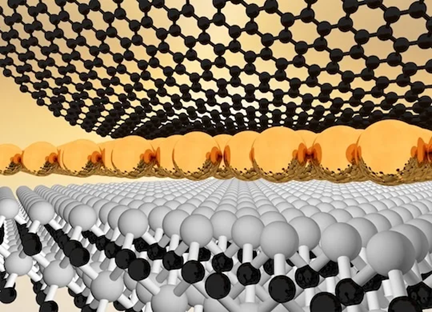In a recent study published in Science Advances, Rice University researchers and partners established a powerful type of interference between phonons, the vibrations in a material’s structure that create the smallest units (or quanta) of heat or sound in that system.

Rendering of a two-dimensional metal (middle layer) intercalated between a layer of graphene (top) and silicon carbide (bottom). Image Credit: Kunyan Zhang
Waves of various types, including light, sound, and atomic vibrations, can interact with one another in the same way as overlapping ripples on a pond can magnify or cancel each other out. At the quantum level, this type of interference drives high-precision sensors and could have applications in quantum computing.
Fano resonance, the phenomenon in which two phonons with distinct frequency distributions interact with one another, was two orders of magnitude larger than previously observed.
While this phenomenon is well-studied for particles like electrons and photons, interference between phonons has been much less explored. That is a missed opportunity, since phonons can maintain their wave behavior for a long time, making them promising for stable, high-performance devices.
Kunyan Zhang, Study First Author and Former Postdoctoral Researcher, Rice University
The discovery paves the way for a new generation of phonon-based technologies by showing that phonons can be manipulated much like light or electrons. The team’s solution relies on the application of a two-dimensional metal on top of a silicon carbide base.
Using a process known as confinement heteroepitaxy, the researchers intercalated a few layers of silver atoms between a layer of graphene and silicon carbide, resulting in a tightly bonded interface with exceptional quantum features.
“The 2D metal triggers and strengthens the interference between different vibrational modes in silicon carbide, reaching record levels,” Zhang noted.
The researchers investigated how phonons interact with each other using Raman spectroscopy, a method for measuring a material's vibrational modes. The spectrum exhibited a severely uneven line shape and, in some cases, a full dip, resulting in an antiresonance pattern characteristic of intense interference.
The result was heavily reliant on the silicon carbide surface’s specificities. An examination of three different silicon carbide surface terminations indicated a strong relationship between each surface and its distinct Raman line form. Furthermore, when the researchers added a single dye molecule to the surface, the spectral line form shifted substantially.
Zhang noted, “This interference is so sensitive that it can detect the presence of a single molecule. It enables label-free single-molecule detection with a simple and scalable setup. Our results open up a new path for using phonons in quantum sensing and next-generation molecular detection.”
Exploring the dynamic of the phenomenon at low temperatures, the researchers found that the interference was caused only by phonon interactions rather than electrons, a rare occurrence of phonon-only quantum interference.
The effect was only detected in the study’s 2D metal/silicon carbide combination and does not occur in typical bulk metals. This is owing to the unique transition paths and surface topologies made possible by the atomically thin metal layer.
The study also looked at the idea of employing other 2D metals, such as gallium or indium, to achieve similar outcomes. By fine-tuning the chemical composition of these intercalated layers, researchers can develop unique interfaces with specific quantum features.
Compared to conventional sensors, our method offers high sensitivity without the need for special chemical labels or complicated device setup. his phonon-based approach not only advances molecular sensing but also opens up exciting possibilities in energy harvesting, thermal management, and quantum technologies, where controlling vibrations is key.
Shengxi Huang, Study Corresponding Author and Associate Professor, Electrical and Computer Engineering and Materials Science and Nanoengineering, Rice University
The study was funded by the National Science Foundation (2011839, 2246564, 1943895, 2230400), the Air Force Office of Scientific Research (FA9550-22-1-0408), the Welch Foundation (C-2144), and the University of North Texas.
Journal Reference:
Zhang, K., et al. (2025) Tunable phononic quantum interference induced by two-dimensional metals. Science Advances. doi.org/10.1126/sciadv.adw1800.